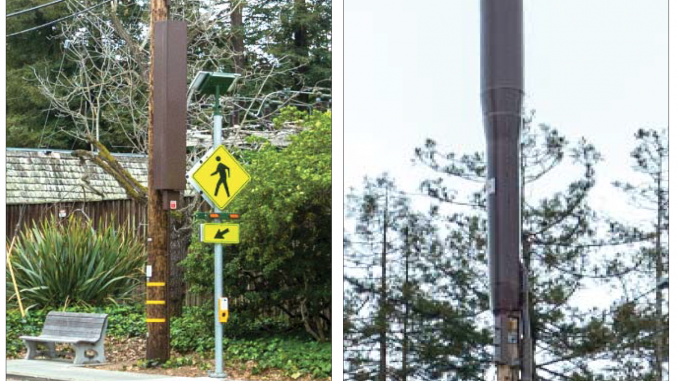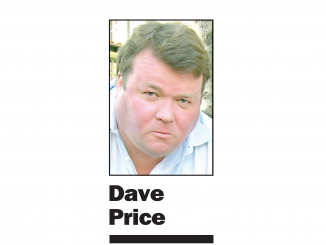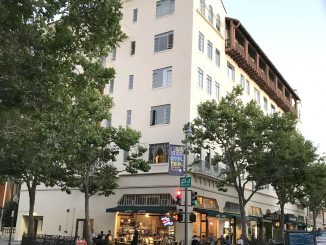
BY ELAINE GOODMAN
Daily Post Correspondent
Palo Alto residents are protesting a plan by Verizon Wireless to install 11 “small cell nodes” — equipment intended to improve coverage and capacity of wireless networks — on utility poles around the city.
Much of the equipment would be covered by a long brown box, referred to as a shroud, on the side of the utility pole. The antenna, which would be placed at the top of the utility pole, would also be covered with a brown shroud.
Despite the shrouds, residents say the equipment is unsightly and should be placed in underground vaults instead. Some note that the city is working to underground its utility equipment.
Some residents are concerned about potential health impacts of radiation emitted by the cellular equipment. Others say Verizon’s new cellular tower proposed at 1082 Colorado Ave. will take care of coverage issues in the area. The city hasn’t yet received an application from Verizon for the tower, according to a report to the City Council. The city’s planning director approved the 11 small cell nodes on March 26, following the Architectural Review Board’s recommendation for approval on March 15. Seven separate appeals have been filed protesting the approval. The City Council is scheduled to hear the appeals Monday (May 21).
Herc Kwan, who lives near one of the proposed sites on Louis Road, said that the pole-mounted cellular equipment would reduce the value of his property.
“Palo Alto is undergrounding the utilities everywhere in the city, including in our neighborhood,” Kwan said in his appeal. “Why should Verizon be permitted to add to a problem the city is in the process of rectifying?”
Undergrounding
Kwan and some of the other appellants would be OK with the small cell antenna being mounted on the pole, as long as the remaining equipment was underground.
Verizon analyzed the feasibility of placing the cellular equipment underground. In many cases, the proposed locations are in a flood zone, the company said. Although sump pumps could be installed to remove small amounts of water from the vault, the vaults could not be flood-proofed.
“This would result in the radios inside the vault to be fully submerged in water and unable to operate,” Verizon said.
In other cases, Verizon said, there’s no room for an underground equipment vault because of the proximity of such items as street trees, ADA sidewalk ramps, utility poles, mailboxes, or fire hydrants.
Noise might also be an issue for the equipment installed in an underground vault, Verizon said, due to the need to circulate air. In contrast, equipment mounted on a utility pole would not make noise. In response to resident concerns, the company agreed not to use a noise-producing backup battery.
The council hearing Monday will focus on the 11 nodes that were approved. But the decision could have implications for other nodes that are in the planning stages. Altogether, Verizon and its contractor, Vinculums, want to install 93 nodes in various places throughout the city. Other wireless carriers have plans for small cell nodes in Palo Alto, too.
Four of the appeals protest individual locations for the small cell nodes. The other three object to all 11 nodes.
Jeanne Fleming, who said she was acting on behalf of a group called United Neighbors, appealed the approval of all 11 nodes.
Cheaper for Verizon?
Fleming said the group supports advances in telecommunications. But the equipment to support it should be “thoughtfully integrated” into neighborhoods, she said.
“Truth be told, there is only one reason why Verizon wants to install its equipment on utility poles rather than to place it in underground vaults: Above-ground installations are cheaper,” Fleming said in her appeal. “We see no reason why the quality of life in our neighborhoods should be compromised to allow Verizon to save money.”
Fleming suggested that Verizon use waterproof radios so that flooding of the vaults would not be a problem.
Regarding concerns about the potential health effects from radiation, City Manager Jim Keene said in a report to the council that the city is not allowed to consider that as a factor in its decision, as long as the wireless provider’s proposal meets federal standards.
Consumer demand
Verizon said its proposed small cell nodes would have minimal visual impact and are needed to meet communication demands — even with its plans for a new cell tower.
“Due to increasing demands from residents and motorists on local roadways, Verizon Wireless RF design engineers determined that both the approved facilities and a new macro facility proposed for 1082 Colorado Ave. will be required to provide reliable network capacity within the Midtown, Palo Verde and St. Claire Gardens neighborhoods,” the company said in responding to the appeals.
According to information on the city’s website, “the small cells improve coverage and capacity in high-traffic areas and ensure mobile broadband capacity to serve the needs of data-intensive users.”
And many in Palo Alto support the addition of small cell nodes, Verizon said, citing results of a text-message survey of Palo Alto customers last year in March and September.
“Palo Alto has awful reception for Verizon users,” one person replied. “Would love to have better service!”
“Even tiny out-of-the-way hamlets have better cell service than Palo Alto,” another respondent said.
Verizon’s 11 small cell nodes that are the subject of a City Council hearing on Monday would be near the following Palo Alto addresses:
2490 Louis Road
2802 Louis Road
891 Elbridge Way
949 Loma Verde Ave.
3409 Kenneth Drive
795 Stone Lane
3090 Ross Road
836 Colorado Ave.
419 El Verano Ave.
201 Loma Verde Ave.
737 Loma Verde Ave.




Ugly little buggers! And I suppose that once the city gives the greenlight to Verizon, AT&T and Sprint will want the same concession.
It’s true that Palo Alto has lousy cell service. Too bad a compromise can’t be reached here, where there’s no noise or radiation for the residents who live near these nodes, but the rest of us can use our phones.
How do you think cell phones work? It’s *electromagnetic radiation* aka *radio waves* — it’s NOT nuclear radiation. No radio waves equals no cell phone service… there’s no compromise in the laws of nature.
At some point we’ve got to draw the line when it comes to neighborhood intrusions. These “nodes” might not seem significant to some people, but if you’ve got one in your front yard, it’s a problem.
How about a compromise. If a Verizon antenna reduces a home’s value, Verizon should pay the homeowner the difference.
and if the prospective buyer *likes* having good cell service then you should pay Verizon the difference? How do you think you would measure this??
This will be just the beginning. Once these are approved, there will be more companies that will want their own antennas. We’ll have hundreds of these on every block if council doesn’t stop it now.
AT&T already has small cell antennas in a number of places in Palo Alto. How many cell phone service providers do you think there are? AT&T, Verizon, T-Mobile, and Sprint are the only cellphone physical infrastructure providers in this area.
The equipment is really ugly and the fans make a hissing sound. Having the antennas is probably a necessary evil – having Verizon conceal the equipment is a demand that Palo Alto city should have pushed for. The city did a “bend over” for Verizon – losing faith in the people we elect. Shows how weak our elected officials are. Oh sorry did I say – “bend over”. Now t-mobile & Sprint will be rushing soon to hang their ugly equipment on rest of the poles – “Think underground” that’s good for the property values and over all beauty of Palo Alto.